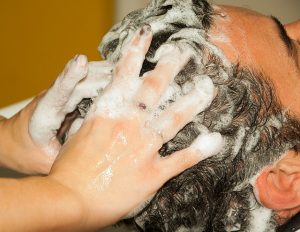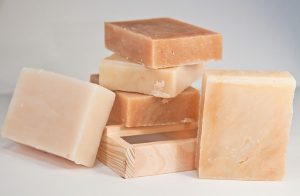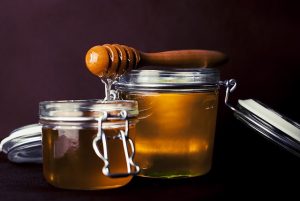 Many shampoos have chemicals in them that aren’t very good for you. An all natural shampoo is better for you. There are plenty of all natural shampoos available for purchase, but what if there weren’t any available? Could you make all natural shampoo if you had to? Most of those all natural shampoos still have a lot of ingredients.
Many shampoos have chemicals in them that aren’t very good for you. An all natural shampoo is better for you. There are plenty of all natural shampoos available for purchase, but what if there weren’t any available? Could you make all natural shampoo if you had to? Most of those all natural shampoos still have a lot of ingredients.
I did some research to see what sorts of simple all natural shampoos could be made from ingredients that could be included in a long term storage plan or could be made from renewable ingredients. Reading up on the options, they all caution that some work better for some people than others. So you will need to do a little experimentation to see what works for your hair before deciding what to prepare. One thing to note is that you aren’t going to get a lather like traditional shampoos.
Below I describe three shampoo options: soap, homemade honey shampoo and homemade apple cider vinegar shampoo.
This post contains affiliate links. That means if you click on a link to a product, I may receive, at no extra cost to you, a small commission when you make a purchase. Thank you for your support.
Soap, In Your Hair?
 The most all purpose option would be good old fashioned soap. In the old days, you made your own soap and used it for skin, shampoo, household cleaning, laundering, in short, everything! If you want to know more about the history of soap that you ever imagined was available, check out COLONIAL SOAP MAKING- ITS HISTORY AND TECHNIQUES.
The most all purpose option would be good old fashioned soap. In the old days, you made your own soap and used it for skin, shampoo, household cleaning, laundering, in short, everything! If you want to know more about the history of soap that you ever imagined was available, check out COLONIAL SOAP MAKING- ITS HISTORY AND TECHNIQUES.
The most basic recipe for soap has just three ingredients: lye, water and one of the following types of fat: tallow (fat from cattle), lard (fat from pigs) or grease (used cooking oil). Despite the short list of ingredients, soap making is somewhat difficult, time-consuming and could be dangerous with curious small children around. For these reasons, soap is something you will want to include in your long term storage.
Lots of people enjoy the art of soapmaking, however, so it could still something you might want to learn to make. When you first start out, I would recommend buying lye and some tallow, lard or oils rather than making your own.
Lye can be purchased quite cheaply at most local hardware stores, but it is very caustic and can burn your skin. Because of this, if you have have small children around, you will not want to keep any around as part of your storage plans. If you want to make your own lye, it can be made from the ashes of burned hardwoods. Here is a wiki-how article How to Make Lye that explains it well.
As I mentioned before, the fat can be one of three different options: tallow (fat from cattle), lard (fat from pigs) or grease (used cooking oil). Most likely you will store up a good amount of cooking oils, so that will probably be your first choice for fat. If you do have cattle or pigs, you may want to use the waste fats from your animals. Here is an article How to Render Tallow for Making Soap describing how to render tallow so you can use it for making your soap.
Honey Shampoo
 This option only has two ingredients: water and raw and unfiltered honey. The ratio of water to honey varies so you might want to try a few different recipes. The most common recipe I saw called for 1 Tbsp of honey and 3 Tbsp of water. Other recipes had as much as 1/2 cup of water per 1 Tbsp of honey.
This option only has two ingredients: water and raw and unfiltered honey. The ratio of water to honey varies so you might want to try a few different recipes. The most common recipe I saw called for 1 Tbsp of honey and 3 Tbsp of water. Other recipes had as much as 1/2 cup of water per 1 Tbsp of honey.
Honey can mold easily, so the most renewable way to plan for honey is to keep your own bees. Since you may not have your own bees yet, here is a link to a raw and unfiltered honey that you can use to test this option on your hair. You won’t want to use the non-raw honey that is in most grocery stores as it is hard to know what it was processed with.
Caution: Children under 1 year old are not supposed to eat honey, so honey shampoo probably isn’t going to be a good option for infants.
Apple Cider Vinegar Shampoo
This option also only has two ingredients: water and apple cider vinegar (ACV). The ratio of water to apple cider vinegar seems to be pretty consistently 1 cup water to 1 Tbsp ACV. Bragg Organic Raw Apple Cider Vinegar is the brand of ACV that we have in our refrigerator. As with the honey, you will want to make sure the apple cider vinegar that you choose is raw and preferably organic.
If you want to make this the most renewable way, then planting an apple tree is a good choice. Apple cider vinegar is pretty easily made by putting apple cores in a jar of water in your pantry without a lid for a couple of weeks.
Have You Used Any Of These As Shampoo?
I have used apple cider vinegar shampoo and it didn’t work well for me. I have not tried the other two, but I would like to try the honey shampoo option. Please leave me a comment below with your experiences.
I like the honey shampoo idea, sounds fun. And the apple cider vinegar shampoo, what kind of smell would that have? Would it be nice or could you smell the vinegar? Some helpful tips here though, that’s for sure.
Summerly, thanks for reading and commenting. The ACV smells a little vinegary when you use it, but once you rinse it out, your hair does not. There is just the very faintest hint of apple.
As a Beauty Therapist I’ve found this post fascinating, soap can really dry your skin out but love your ideas and have never given any thought to making my own 🙂
I love honey and the thought of owning a Bee Hive would be incredible, your Honey Shampoo ingredients are so easy and again something I would not have thought about until now, think I had better get started 🙂
Inspired!!
Thank you!
June, thanks for the comment. I agree that having a bee hive to have our own honey would be amazing. I am also looking forward to trying the honey shampoo.
Never think about it before. I like to try it specially on my daughter. Thanks for the info!
Jean, thanks. Hope your daughter finds one she likes.